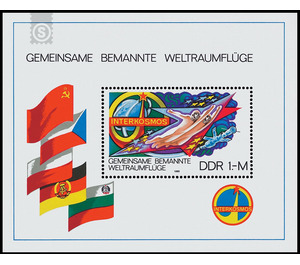Intercosmos program: Common manned space flights - Germany / German Democratic Republic 1980
Theme: Art & Culture
| Country | Germany / German Democratic Republic |
| Issue Date | 1980 |
| Item Type | Block |
| Chronological Issue Number | 3158 |
| Chronological Chapter | GER-DDR |
| SID | 836383 |
| In 21 Wishlists | |
Joint manned space flights In recognition of the previous joint manned space flights within the framework of the INTERKOSMOS program, the Ministry of Posts and Telecommunications of the German Democratic Republic is issuing a multi-color special postage stamp block. No special First Day Cover Special cancellation from 11 April to 10 June 1980 Joint manned space flights In July 1976, the USSR submitted to the participating countries the Interkosmos Research Program - People's Republic of Bulgaria, Czechoslovakia, GDR, Republic of Cuba, Mongolian People's Republic, Socialist Republic of Romania, Hungarian People's Republic Proposal to allow citizens of their countries to take part in manned space flights of the USSR. This marks the beginning of a new stage in the cooperation of socialist countries in the exploration and use of space for peaceful purposes within the framework of the Interkosmos program. It reaffirmed the fraternal relations between the socialist countries and their disinterested cooperation and once again demonstrated the internationalist attitude of the USSR and the power of socialist integration in the cosmos. The first cosmonaut contenders of the participating countries began training in the cosmonaut training center Yuri Gagarin "near Moscow in 1976. In addition to the original program, citizens of the Socialist Republic of Vietnam were later included in training, and so far have four international crews The Soviet spaceship commander Alexei Gubarev and Czechoslovakian citizen Vladimir Remek started with the spaceship Soyuz 28 on March 2, 1973. Soyuz 28 landed on the Orbital Station Salut 6, which had been in orbit since September 26, 1977. Together with Gubarev and Remek conducted numerous scientific experiments of the joint research program, including experiments on remote sensing of the Earth, material science research (Moravia experiment) and biological-medical examinations of the original crew of Salut 6, Yuri Romanenko and Georgy Grechko The national occupation ended on March 10 with the soft landing of Soyuz 28 in Kazakhstan. The flight of the second international crew - spaceship commander Pyotr Klimuk and the citizen of the People's Republic of Poland Miroslaw Hermaszewski - lasted from June 27 to July 5, 1978. Again, a Soyuz spacecraft - Soyuz 30 - docked at Salut 6 Station, in the since June 15, the regular crew Vladimir Kovaljonok and Alexander Ivanchchenkov worked. The scientific program of the flight also provided for a variety of joint experiments, including the continuation of some studies already begun by Gubarev and Remek. The third international crew consisted of spaceship commander Valeri Bykowski and the citizen of the GDR Sigmund Jähn, who were in space from 26 August to 3 September 1978. They lined up with Soyuz 31 Salut 6, in the same crew as the crew flight of Klimuk and Hermaszewski worked. Bykowski and Jähn conducted about 20 scientific experiments, including the experiment "Biosphere" for remote sensing of the Earth and the atmosphere, "Berolina" for the growth of crystals under conditions of weightlessness, further biological and medical investigations. The return was carried out with the spaceship of the crew, Soyuz 29. On March 14, 1979 launched Soyuz 33 with Nikolai Rukavishnikov and the citizen of the People's Republic of Bulgaria Georgi Ivanov. However, the planned goal of docking at the station Salut 6 with the regular crew Vladimir Lyakhov and Valery Ryumin was not achieved. The flight of Soyuz 33 was terminated prematurely after deviations from the established regime in the work of the Soyuz 33 approach and correction engines occurred during the spaceship's approach to the orbital complex. The flight control center then suspended the docking of the spaceship to the station and ordered Soyuz 33 back to Earth.


